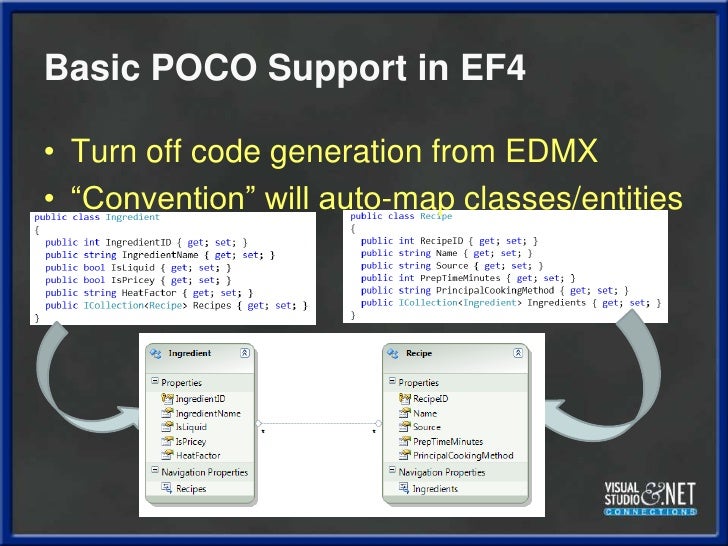Entity Framework Datacontract Serialization
Posted : adminOn 5/12/2018Before explaining the actual issue, let me explain a few concepts of serialization. Entity Object vs. WCF Entity objects are designed so rich, so that if it is chosen. Note that the classes are partial, so just incase we need more members in the Data Contract, we can always write the partial class with additional. Sep 22, 2010 ADO.NET Entity Framework and LINQ to Entities. Object-relational mapping and entity data. The Entity Framework entities as data.

What about keeping a gradually unwound json representation of the entities graph in the proxy, where that graph would match the real POCO and then some contract serializer that serializes back to the POCO could work by convention. I would prefer less moving parts generally speaking, I find this a little too verbose. The second part of the problem, having POCOs come back as Proxies is for me a non issue largely due to the way I would work. Don’t send Entities send messages. Most task based systems are really only concerned with subsets of data that would find their way into what woud become ‘eventual’ entities server (or more accurately service) side.

Many thanks Jeff for the answer. So you mean that when I define (by following your examples) all my collections (1:n relations) on entities as EntityCollection, they are no longer queryable?
That means that working with that entity I am loading whole graph all the time? Or maybe I can get lazy load, but I can not alter generated SQL anymore, as it has already been evaluated to memory (IEnumerable). Or I am missing something Well it works for L2S, care to elaborate>What is behind this decision and so on I’ll look on CreateSourceQuery(), thanks for pointing that out! Wishing you all the best to New Year 2010!
@EF Newbie Correct, an EntityCollection is no longer queryable. Any LINQ operators you do on it will be doing LINQ to Objects over the data already in the collection. Stoll M1 Plus Crackers here. However, this is different than bringing down an entire graph. LINQ to SQL has a 'DataLoadOptions' capability that allows you to bring down a customer and all of its orders in one query. The Entity Framework also supports this through the Include() method on the ObjectQuery class.
You can do something like this: ctx.Customers.Include('Orders').Where() This will bring down the whole graph. We are looking to add capabilities to this in the next release as well, including making EntityCollection more queryable. I tried the implementation of the ApplyProxyDataContractResolverAttribute as described here, and also tried using the attribute code with the default ProxyDataContractResolver shipped in the RC. Neither seemed to work. So long as the entity has had a navigation property initialized I can’t seem to get it to serialize via WCF. The problem seems to come when an EntityCollection is initialized, and unfortunately it doesn’t get set to null even if empty and detached from the context.
In the meantime I basically create a new Entity in the WCF layer with only the scalar properties and I can serialize that no problem, kind of a pain though! From Jason's post: 'The problem seems to come when an EntityCollection is initialized, and unfortunately it doesn't get set to null even if empty and detached from the context.' This is what I'm experiencing as well. Ferris 3100z Service Manual.
Data Toolbar Keygen Photoshop. I have a many-to-many relationship and when I explicitly load the navigation property of one entity, the navigation counterpart property on the other entity is already populated and I'm screwed on serialization. (Haven't had any of the circular-reference fixes for WCF serialization work.).
Hi Burhan, Based on MSDN document: 'If you want the Entity Framework to track changes in your POCO classes as the changes occur and support lazy loading of the related objects, your POCO classes must meet the requirements described in the topic'. Please also check the Serializing POCO Proxies section of the document to serialize the POCO entities. Best Regards, Lingzhi Sun Please remember to mark the replies as answers if they help and unmark them if they provide no help. If you have any feedback, please tell us. Hi Burhan, Based on MSDN document: 'If you want the Entity Framework to track changes in your POCO classes as the changes occur and support lazy loading of the related objects, your POCO classes must meet the requirements described in the topic'. Please also check the Serializing POCO Proxies section of the document to serialize the POCO entities. Best Regards, Lingzhi Sun Please remember to mark the replies as answers if they help and unmark them if they provide no help.